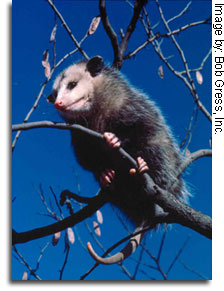Opossum
(Didelphis virginiana)

The opossum is the only marsupial, or pouched mammal, native to North America.
Opossums are grayish white in color and fur covers the whole body, except for
its ears and tail. The opossum has a long, scaly prehensile tail, which is
adapted for grasping and hanging. These marsupials can weigh anywhere from 4 to
13 pounds, and their body can range from 15 to 20 inches long with a 9 to 20
inch long tail.
Opossums are common and abundant throughout Maryland and the eastern United
States. They also can be found in parts of Arizona, California, Washington and
Oregon.
Habitat:
Opossums can be found in a variety of habitats. Opossums naturally prefer
deciduous woods near water but can also be found in farmlands or marshes.
Opossums can also be found throughout urban and suburban environments.
Diet:
Opossums are omnivores. This means they eat a varied diet of insects, worms,
frogs, birds, fruits, nuts and carrion (dead animals). They will also eat small
rodents, voles, shrews and moles. Opossums are often seen feeding at compost
piles, garbage cans and bird feeders.
Reproduction:
Opossums breed from January to July. Twelve to thirteen days after breeding, the
young will be born. Baby opossums are only the size of a honeybee at birth and
will live and nurse in the mother’s pouch for two months. When the young leave
the pouch, the female will often carry the young on her back.
Sounds:
Opossums make few sounds. Sometimes, opossums will hiss or make a slight growl
if they feel threatened or during fights in the mating season. Females will also
make a clicking noise to their young, and the young, if separated from their
mother, will make a slight “choo choo” call or a sneezing noise to communicate.
Behavior:
Opossums are nomadic and never really establish their own territory. Opossums
are primarily nocturnal and will wander throughout areas in the night in search
of food. During the day, opossums will seek refuge in hollow trees, under
porches, in brush piles, other animal’s burrows, etc.
Opossums use several techniques to avoid predators. In one technique, opossums
will freeze to avoid being seen by a predator. Opossums also will fake illness
by drooling excessively and swaying back and forth. Many predators will avoid
sick prey.
Did You Know?
Opossums are highly resistant to diseases such as rabies because of their
efficient immune system and lower body temperature. Opossums can not hang upside
down by their tail, but use their tail to climb. Opossums have exactly 50 teeth
which is more than any other North American land mammal. The opossum also has
opposable thumbs on its hind feet for holding onto branches.
Opossums are managed as furbearers in Maryland. For more information on
furbearer management, then please
click here.